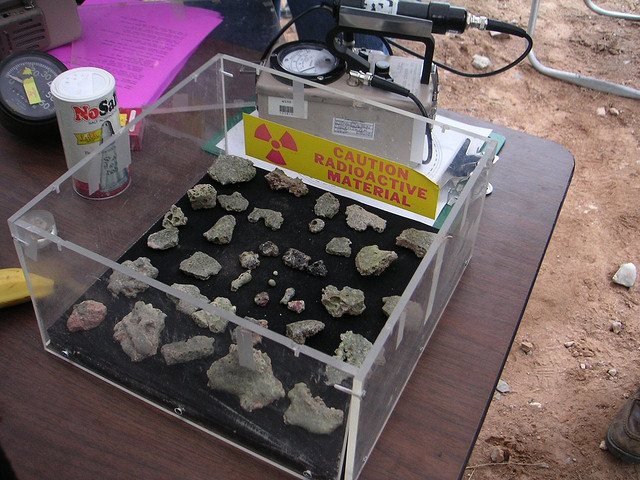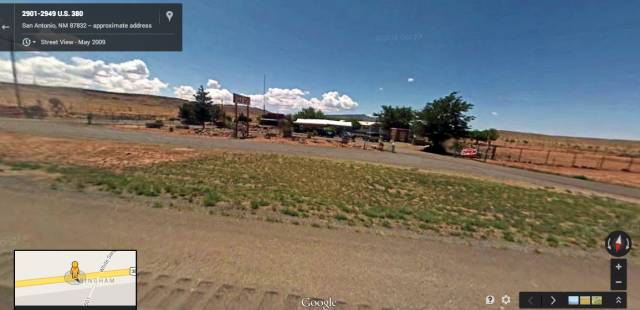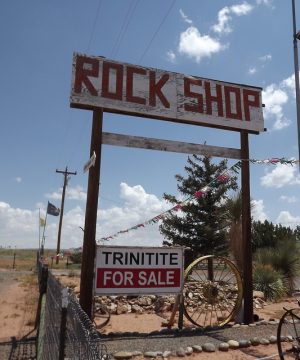New Mexico, land of strange enchantment —
From the archives: A short story about a strange glass.
Megan Geuss
–

Trinitite specimens.
Update, 5/29/21: It’s Memorial Day weekend in the US, and staff are trying to stay away from the keyboard accordingly. As such, we’re resurfacing a few classic pieces from our archives. This one originally ran on September 1, 2014 and details a long weekend-appropriate road trip adventure to come face-to-face with an artifact of past military activity.
Four months ago in April 2014, Ars Technica sent me out to Alamogordo, New Mexico to be present at the unearthing of a landfill that was long-rumored to hold a trove of Atari games, dumped at the site after the video game crash of 1983. As I was preparing for the trip, my coworkers and I chatted about the event in the editors’ IRC channel.
”When you’re hanging out in the trash dump be sure to look out for Trinitite,” automotive editor Jonathan Gitlin told me.
”What’s Trinitite?” I asked. He explained that it was a type of radioactive glass that formed during the first test of the first nuclear bomb in 1945. I did a quick Google search and understood (somewhat incorrectly) that collecting and selling Trinitite had been made illegal long ago. I made a mental note to keep an eye out for the murky green or red glass when I was in Alamogordo, and I finished booking my motel room.
Fast forward two weeks. Atari games had been dug up from the landfill, a handful of reports and analysis had been written and recorded, and I checked out of my Days Inn, casting one last wistful glance at the make-your-own-waffle station in the lobby. I drove out of Alamogordo around 5 p.m. in my rented Chevy Cruze, now caked with thick, red landfill mud all over the doors and wheels and bumper.
I had 15 hours left in New Mexico before I had to fly back home out of Albuquerque, and I was disappointed that I hadn’t had the chance to go to White Sands or to the nearby New Mexico Museum of Space History. Instead, I thought, I would console myself with roadside pit stops. I got barbecued something and cornbread filled with bits of peppers. I stopped at the world’s largest pistachio statue (unverified) and pistachio-themed gift store. I got gas and some candy in Carrizozo.
Driving west on highway 380 out of Carrizozo on a Sunday night, there was no one on the road—just me and the most magnificent spring New Mexico sunset with hues that ranged from oranges to purples with a couple of white clouds wafting above it all. After fiddling with my rental’s satellite radio for a while, I settled down and I soon realized I hadn’t seen a single car going either way on the highway for at least 30 minutes. Nor had I seen a gas station. There were rest stops, but they were different than the California rest stops I’m used to where there’s a bathroom and a vending machine to mimic the amenities and comforts of a storefront without having to pretend like you’re buying something from the AmPm. Off 380, the rest are basically just picnic tables under an awning.

Enlarge / Google Earth shows us the rock shop off New Mexico’s highway 380.
But then, out of no where, a little house appeared with the words “ROCK SHOP” in big letters and “TRINITITE” on two different signs.
”Heh,” I thought, “Too bad I never found any of that in the desert.”
As I drove past the rock shop, “Hits of the ’80s” XM radio station blaring, I thought, “Wait they’re selling illegal Trinitite? Hell, when’s the next time I’ll be in New Mexico? I should get some Trinitite for Jonathan!”
I screeched the car to a halt and pulled a U-turn on the empty highway, sent a flock of birds flying, and drove the three miles back.
As I drove up the gravel driveway to the shop I noticed three cars in front but no lights on. There was still enough light to see, and a sign proclaimed that the store was OPEN but when I got out of the car, the silence around me was immense. A breeze blew and some wind chimes tinkled. I followed the signs directing me back toward a courtyard and saw two big dogs, just silently staring at me.
I walked around a corner, and there I found several big, long, plastic tables covered with every type of rock, and one filled exclusively with mounds of jagged green and gray-green and yellow-green glass. It had to be Trinitite, or what looked like Trinitite.
I looked around to the house behind me and noticed a doorbell on the wall with a sign that said “please ring for assistance.”
But the dusk was settling and the silence around me was growing heavier. I started feeling a growing anxiety about being there. Perhaps it was the vastness of the New Mexico desert, or the two dogs silently watching me, or some sort of ill feeling after having spent eight hours the day before in a landfill with 30 years of trash dust being blown at me. Or maybe it was something even more profound than that: a pang of madness caused by a ripple of the terrible history that played out in this desert. “Now, I am become Death, the destroyer of worlds,” J. Robert Oppenheimer supposedly said, quoting the Bhagavad Gita, upon viewing his atomic bomb explode into a mushroom cloud over the very desert I was standing in on July 16, 1945.
Suddenly I realized how exposed I was. I’m no stranger to hiking alone, but usually I wear good shoes and carry a knife or a big stick just in case. Here, in crummy tennis shoes and a T-shirt, without cellphone reception, without anything in my hands to act as a weapon and only a $20 bill in my pocket, I was positive I could scream and no one would hear it. I imagined myself being dragged down into the rock shop basement, captive there for years as gawking tourists bought trinkets in the safety of full daylight. My radioactive, chainsaw-wielding captor would serve me the bodies of mutant coyotes descended from the packs that roamed the desert in the wake of the Manhattan Project’s opening act.
”Yeah, no, Jonathan will have to live without a Trinitite sample,” I thought and walked briskly out the courtyard and back to my car.
The real Trinitite story
Enlarge / I narrowly escaped… meeting some friendly and knowledgeable rock enthusiasts.
Two hours of driving time and two flights later, I was back home and decided to do more than a cursory Google search into Trinitite and its history. As it turns out, the rock is not illegal to sell (you can buy real samples online, but caveat emptor; some people sell green glass rocks that are not the real stuff) and the people of the rock shop outside of Carrizozo look like awesome and nice people. I even found out that our own copyeditor, Kerry Staurseth, is the proud owner of some genuine Trinitite samples.
Trinitite is, however, illegal to gather. In 1953, the US government forbade it, although the radioactivity in the rocks is present but negligible. (One computer engineer and amateur Trinitite researcher bought samples and found that you are subject to more radioactivity by sleeping next to another human for a year than you would be sleeping with a small sample of Trinitite around your neck. Just don’t swallow it. That would be very bad.)
Even if you were to throw laws and regulations to the wind, gathering Trinitite would be difficult today, as the Trinity site (where the first atomic bomb was detonated and from whence Trinitite gets its name) is forbidden to the public except for one day a year when visitors can take guided tours. Even then, you may not find much Trinitite, because when the US government put the kibosh on gathering, it also reportedly dug up much of the remaining Trinitite and buried it in the New Mexico desert.
Just like all those Atari games, people can’t help but bury their dark secrets in the New Mexico desert.
Ars contacted Nelson Eby, a professor at the University of Massachusetts at Lowell who researches Trinitite, and asked him to give us some background. Eby co-authored a 2010 article in Geology Today, which explained that when the atomic bomb was detonated, the desert sand was swept up by the blast and liquified by the heat, creating Trinitite. Eby’s paper explained:
“Contained within the glass are melted bits of the first atomic bomb and the support structures and various radionuclides formed during the detonation. The glass itself is marvelously complex at the tens to hundreds of micrometre scale, and besides glasses of varying composition also contains unmelted quartz grains. Air transport of the melted material led to the formation of spheres and dumbbell shaped glass particles. Similar glasses are formed during all ground level nuclear detonations and contain forensic information that can be used to identify the atomic device.
Eby and his peers were permitted by the US government to collect Trinitite samples directly from the site. (“It is ILLEGAL to collect samples of Trinitite from the Trinity site (you need to know that, I don’t want any of your readers getting arrested, fined, and incarcerated),” Eby wrote to Ars in an email.) In conducting analysis on the rocks, he found that the mix of minerals in the glass gave hints to what happened to the surrounding desert when Oppenheimer’s plutonium bomb exploded. The sand around the Trinity site, for example, showed signs of uneven melting.

More Trinitite samples.
“In the case of multicomponent systems, melting takes place over a range of temperatures,” Eby explained. “For example, if we had a mixture of minerals similar to those that make up the sand at the Trinity site, and we heated this mixture, we would find a specific temperature at which it would start to melt (let’s say 750 degrees C). This would be the minimum melting point. If we kept the mixture at 750 for time immemorial only a certain amount of the material would melt. We would have to raise the temperature in order for more melting to take place and we might find that we needed to raise the temperature several hundred degrees for complete melting.”
“The meaning in terms of Trinity is that things got very hot very fast but didn’t stay hot very long (we’re talking seconds),” Eby said.
Eby’s research is a part of what is a tiny renaissance of nuclear forensics. “Currently there is very active research on the Trinity glasses to understand what they can tell us about a nuclear detonation,” Eby wrote to Ars. “Literally millions of dollars are being spent on these studies.”
Geology at Trinity also has obvious applications beyond understanding our own military history; perhaps it can give us some insight into the violence imparted on our tiny planet by the unfeeling cosmos. “There are a number of similarities between what happens when there is a meteorite impact and a nuclear explosion,” Eby wrote.
So, although my fears and concerns about Trinitite and its purveyors were wildly unfounded, it led me to learn about a cool slice of modern geology and modern history. And next time I’m in New Mexico, I’m definitely going to get Jonathan a big hunk of radioactive glass.
Listing image by Jane Hammons

